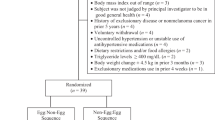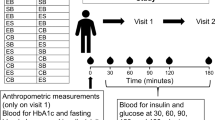Abstract
Objective:
To test the hypotheses that an egg breakfast, in contrast to a bagel breakfast matched for energy density and total energy, would enhance weight loss in overweight and obese participants while on a reduced-calorie weight loss diet.
Subjects:
Men and women (n=152), age 25–60 years, body mass index (BMI) ⩾25 and ⩽50 kg m−2.
Design:
Otherwise healthy overweight or obese participants were assigned to Egg (E), Egg Diet (ED), Bagel (B) or Bagel Diet (BD) groups, based on the prescription of either an egg breakfast containing two eggs (340 kcal) or a breakfast containing bagels matched for energy density and total energy, for at least 5 days per week, respectively. The ED and BD groups were suggested a 1000 kcal energy-deficit low-fat diet, whereas the B and E groups were asked not to change their energy intake.
Results:
After 8 weeks, in comparison to the BD group, the ED group showed a 61% greater reduction in BMI (−0.95±0.82 vs −0.59±0.85, P<0.05), a 65% greater weight loss (−2.63±2.33 vs –1.59±2.38 kg, P<0.05), a 34% greater reduction in waist circumference (P<0.06) and a 16% greater reduction in percent body fat (P=not significant). No significant differences between the E and B groups on the aforementioned variables were obtained. Further, total cholesterol, high-density lipoprotein cholesterol, low-density lipoprotein cholesterol and triglycerides, did not differ between the groups.
Conclusions:
The egg breakfast enhances weight loss, when combined with an energy-deficit diet, but does not induce weight loss in a free-living condition. The inclusion of eggs in a weight management program may offer a nutritious supplement to enhance weight loss.
This is a preview of subscription content, access via your institution
Access options
Subscribe to this journal
Receive 12 print issues and online access
$259.00 per year
only $21.58 per issue
Buy this article
- Purchase on Springer Link
- Instant access to full article PDF
Prices may be subject to local taxes which are calculated during checkout

Similar content being viewed by others
References
World Health Organization. World Health Report—Life in the 21st Century: A Vision for All. WHO: Geneva, 1998.
Ogden CL, Carroll MD, Curtin LR, McDowell MA, Tabak CJ, Flegal KM . Prevalence of overweight and obesity in the United States, 1999–2004. JAMA 2006; 295: 1549–1555.
Allison DB, Fontaine KR, Manson JE, Stevens J, VanItallie TB . Annual deaths attributable to obesity in the United States. JAMA 1999; 282: 1530–1538.
Calle EE, Rodriguez C, Walker-Thurmond K, Thun MJ . Overweight, obesity, and mortality from cancer in a prospectively studied cohort of US adults. N Engl J Med 2003; 348: 1625–1638.
Fontaine KR, Redden DT, Wang C, Westfall MS, Allison DB . Years of life lost due to obesity. JAMA 2003; 289: 187–193.
Must A, Spadano J, Coakley EH, Field AE, Colditz G, Dietz WH . The disease burden associated with overweight and obesity. JAMA 1999; 282: 1523–1529.
Peeters A, Barendregt JJ, Willekens F, Mackenbach JP, Al Mamun A, Bonneux L . Obesity in adulthood and its consequences for life expectancy: a life-table analysis. Ann Intern Med 2003; 138: 24–32.
Thompson D, Edelsberg J, Colditz GA, Bird AP, Oster G . Lifetime health and economic consequences of obesity. Arch Intern Med 1999; 159: 2177–2183.
Kolotkin RL, Meter K, Williams GR . Quality of life and obesity. Obes Rev 2001; 2: 219–229.
Puhl R, Brownell KD . Bias, discrimination, and obesity. Obes Res 2001; 9: 788–805.
Drewnowski A . Energy density, palatability, and satiety: implications for weight control. Nutr Rev 1998; 56: 347–353.
Poppitt SD . Energy density of diets and obesity. Int J Obes 1995; 19: S20–S23.
Rolls BJ, Bell EA . Dietary approaches to the treatment of obesity. Med Clin North Am 2000; 84: 401–418.
Stubbs J, Ferres S, Horgan G . Energy density of foods: effects on energy intake. Crit Rev Food Sci Nutr 2000; 49: 481–515.
Rolls BJ, Bell EA, Thorwart ML . Water incorporated into a food but not served with a food decreases energy intake in lean women. Am J Clin Nutr 1999; 70: 448–455.
Rolls BJ, Castellaos VH, Halford JC, Kilara A, Panyam D, Pelkman CL et al. Volume of food consumed affect satiety in men. Am J Clin Nutr 1998; 67: 1170–1177.
Burton-Freeman B . Dietary fiber and energy regulation. J Nutr 2000; 130 (suppl): 272–275.
Howarth NC, Huang TTK, Roberts SB, McCrory MA . Dietary fiber and fat are associated with excess weight in young and middle-aged US adults. J Am Diet Assoc 2005; 105: 1365–1372.
Howarth NC, Saltzman E, Roberts SB . Dietary fiber and weight regulation. Nutr Rev 2001; 59: 129–139.
Rolls BJ, Roe LS, Meengs JS . Salad and satiety: energy density and portion size of a first-course salad affect energy intake at lunch. J Am Diet Assoc 2004; 104: 1570–1576.
Holt SHA, Brand Miller JC, Petocz P, Farmakalidis E . A satiety index of common foods. Eur J Clin Nutr 1995; 49: 675–690.
Holt SHA, Brand Miller JC, Stitt PA . The effects of equal-energy portions of different breads on blood glucose levels, feelings of fullness and subsequent energy intake. J Am Diet Assoc 2001; 101: 767–773.
Vander Wal JS, Marth JM, Khosla P, Jen C, Dhurandhar NV . Short-term effect of eggs on satiety in overweight and obese subjects. J Am Coll Nutr 2005; 24: 510–515.
Stewart AL, Sherbourne CD, Hays RD, Wells KB, Nelson EC, Kamberg CJ et al. Summary and discussion of MOS measures. In: Stewart AL, Ware Jr JE (eds). Measuring Functioning and Well-Being: The Medical Outcome Study Approach. Duke University Press: Durham, NC, 1992, pp 345–371.
Ware Jr JE, Sherbourne CD . The MOS 36-item short-form health survey (SF-36): I. Conceptual framework and item selection. Med Care 1992; 30: 473–483.
Hays RD, Shapiro MF . An overview of generic health-related quality of life measures for HIV research. Qual Life Res 1992; 1: 91–97.
Stunkard AJ, Messick S . The three-factor eating questionnaire to measure dietary restraint, disinhibition and hunger. J Psychosom Res 1985; 29: 71–83.
Laporte DJ, Stunkard AJ . Predicting attrition and adherence to a very low calorie diet: a prospective investigation of the eating inventory. Int J Obes 1990; 14: 197–206.
Westenhoefer J, Stunkard AJ, Pudel V . Validation of the flexible and rigid control dimensions of dietary restraint. Int J Eat Disord 1999; 26: 53–64.
Bish CL, Blank HM, Maynard LM, Serdula MK, Thompson NJ, Khan LK . Health related quality of life and weight loss practices among overweight and obese US adults 2003: behavioral risk factor surveillance system. Med Gen Med 2007; 9: 35.
Teff KL, Young SN, Blundell JE . The effect of protein or carbohydrate breakfasts on subsequent plasma amino acid levels, satiety, and nutrient selection in males. Pharmacol Biochem Behav 1989; 34: 829–837.
Wright JD, Wang CY, Kennedy-Stephenson J, Bethene ER . Dietary intake of ten key nutrients for public health, United States: 1999–2000. Advance Data from Vital and Health Statistics. Centers for Disease Control and Prevention. No: 334 April 17, 2003.
Clarke RFC, Collins R, Appleby P, Peto R . Dietary lipids and blood cholesterol: quantitative meta-analysis of metabolic ward studies. BMJ 1997; 314: 112–117.
Herron KL, Fernandez ML . Are the current dietary guidelines regarding egg consumption appropriate? J Nutr 2004; 134: 187–190.
Herron KL, Vega-Lopez S, Conde K, Ramjiganesh T, Shachter NS, Fernandez ML . Men classified as hypo- or hyperresponders to dietary cholesterol feeding exhibit differences in lipoprotein metabolism. J Nutr 2003; 133: 1036–1042.
Howell WJ, McNamara DJ, Tosca MA, Smith BT, Gaines JA . Plasma lipid and lipoprotein responses to dietary fat and cholesterol: a meta-analysis. Am J Clin Nutr 1997; 65: 1747–1764.
Hu FB, Stampfer MJ, Rimm EB, Manson J, Ascherio A, Colditz G et al. A prospective study of egg consumption and risk of cardiovascular disease in men and women. JAMA 1999; 281: 1387–1394.
Knopp RH, Retzlaff B, Fish B, Walden C, Wallick S, Anderson M et al. Effects of insulin resistance and obesity on lipoproteins and sensitivity to egg feeding. Arterioscler Thromb Vasc Biol 2003; 23: 1437–1443.
McNamara DJ . The impact of egg limitations on coronary heart disease risk: do the numbers add up? J Am Coll Nutr 2000; 19: 540S–548S.
McNamara DJ . Eggs and heart disease risk: perpetuating the misperception. Am J Clin Nutr 2002; 75: 333–335.
Presnell K, Stice E, Tristan J . Experimental investigation of the effects of naturalistic dieting on bulimic symptoms: moderating effects of depressive symptoms. Appetite 2008; 50: 91–101.
Acknowledgements
We acknowledge the contribution of our study coordinator, Ms Natalie Currier, in outpatient visits and follow-up of the study participants.
Author information
Authors and Affiliations
Corresponding author
Additional information
Performance site: Pennington Biomedical Research Center, Baton Rouge, LA 70808, USA.
Funding source: American Egg Board.
Presented at: Experimental Biology 2007.
Rights and permissions
About this article
This article is cited by
-
The effect of whole egg consumption on weight and body composition in adults: a systematic review and meta-analysis of clinical trials
Systematic Reviews (2023)
-
Position statement on nutrition therapy for overweight and obesity: nutrition department of the Brazilian association for the study of obesity and metabolic syndrome (ABESO—2022)
Diabetology & Metabolic Syndrome (2023)
-
A randomized cross-over trial to determine the effect of a protein vs. carbohydrate preload on energy balance in ad libitum settings
Nutrition Journal (2019)
-
Metabolic impact of protein feeding prior to moderate-intensity treadmill exercise in a fasted state: a pilot study
Journal of the International Society of Sports Nutrition (2018)
-
Egg consumption, cardiovascular diseases and type 2 diabetes
European Journal of Clinical Nutrition (2018)



